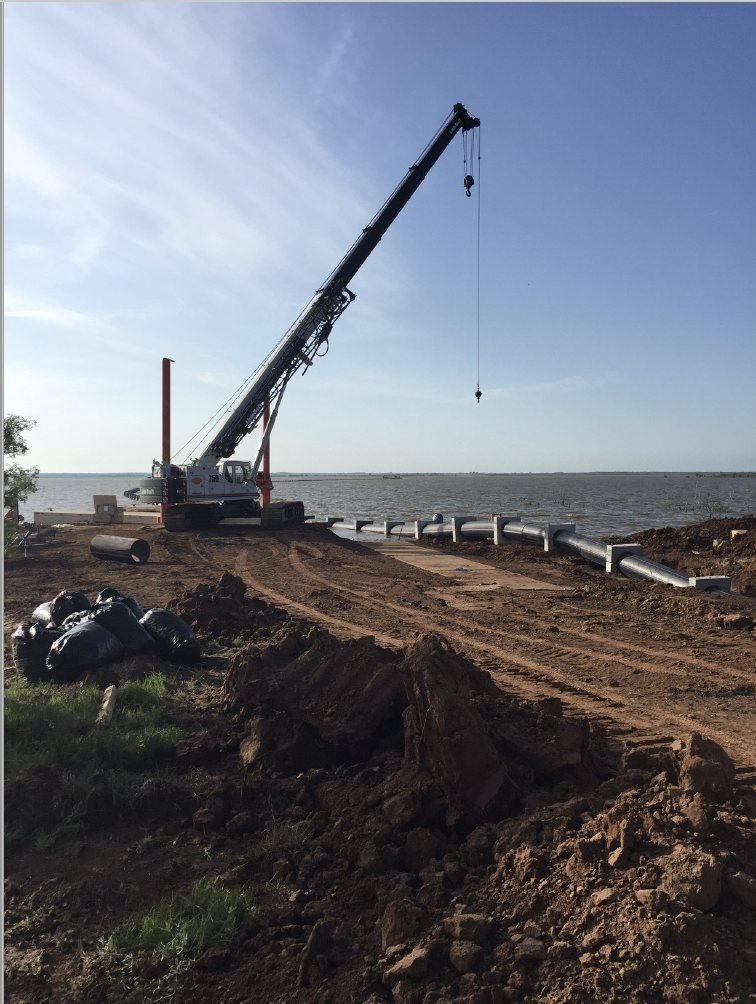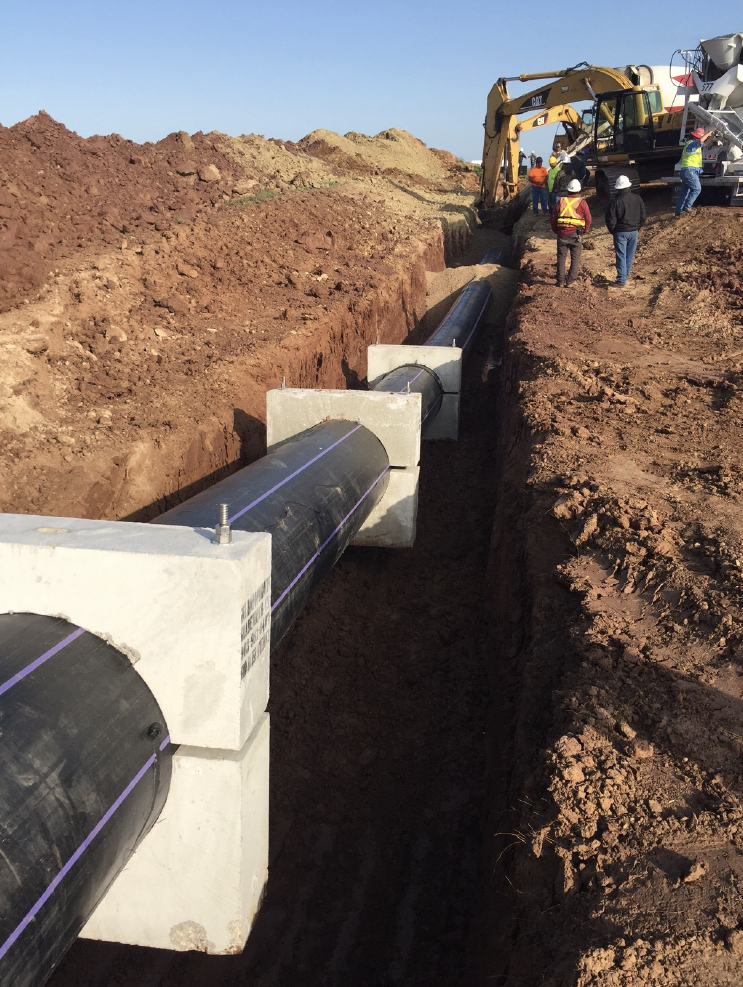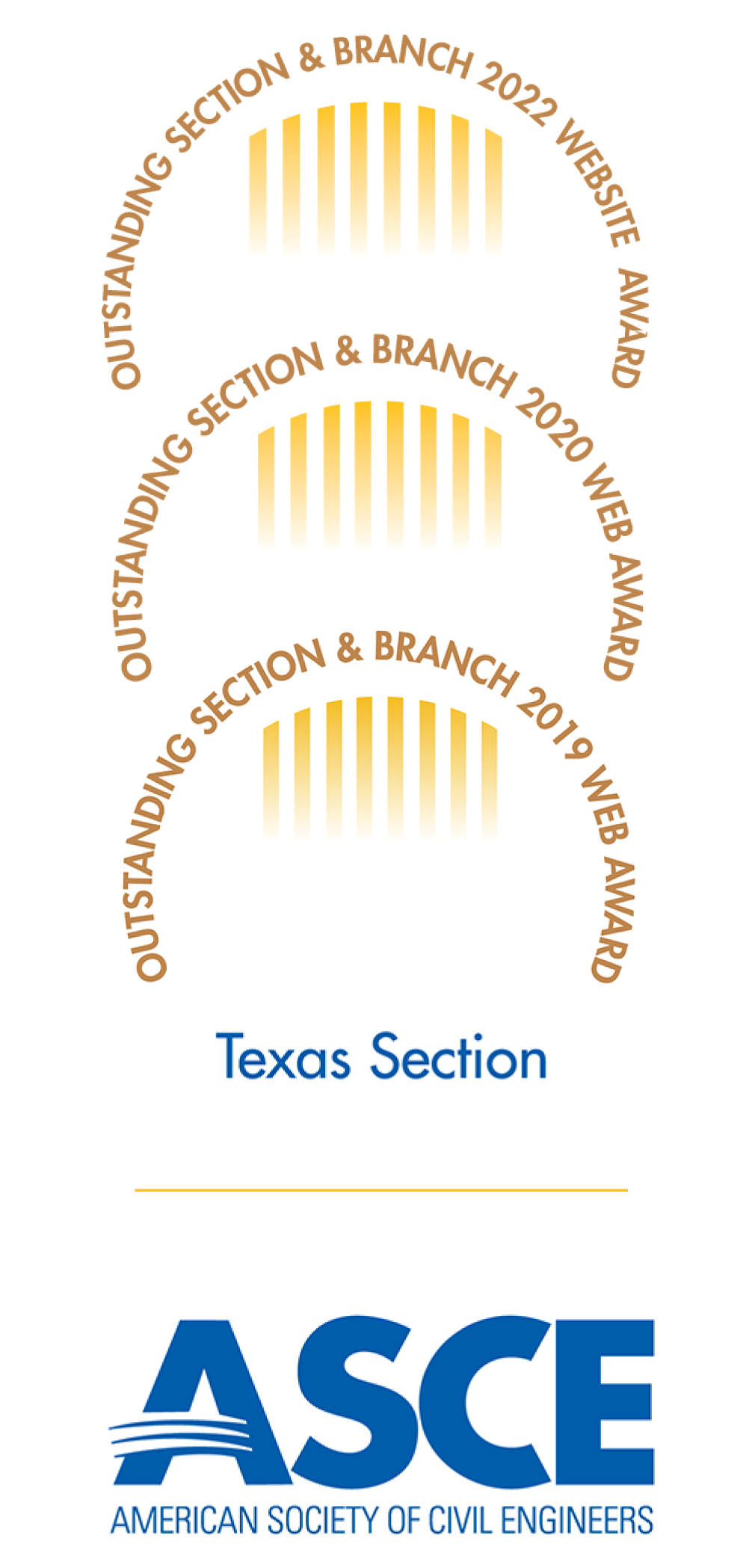The Wichita Falls Direct Potable Reuse & Indirect Potable Reuse Project was presented with the 2019 Texas Outstanding Civil Engineering Achievement (OCEA) Award on September 20, 2019 during CECON 2019 in San Marcos, Texas. The Texas OCEA Award is given to a completed project that demonstrates the greatest contribution to civil engineering progress and society.
In 2011, the State of Texas was in the grips of a statewide drought, with 87.99% of the State in an Exceptional Drought (D4) condition by October 4th.

Click here to enlarge image
The State was experiencing numerous wildfires and the Total Conservation Capacity of water within reservoirs had dropped to 58%. The Wichita Falls had lost 33% of its stored water capacity in just under 12 months, dropping from 86% in November of 2010 to 52.5% in October 2011. Wichita Falls City staff created projections in early 2012, using 2011 weather data, that indicated the City could be out of water as early as the Summer of 2013.
With this data, the City of Wichita Falls approached the Texas Commission on Environmental Quality (TCEQ) about approving its latest Potable Reuse Pilot Study, conducted by Corlett, Probst and Boyd, so it could utilize its wastewater effluent as a source of drinking water. The TCEQ was reluctant to approve the Pilot Study but started a process with the City of Wichita Falls to study, design and construct an Indirect Potable Reuse (IPR) project. The City contracted with Corlett, Probst & Boyd to design the pipeline for the IPR and with CDM Smith to conduct the Water Quality Data Analysis for the receiving lake (Arrowhead) and the wastewater plant improvements design.
The CDM Smith estimate for modeling, permitting, designing and constructing the IPR was five years, putting the completion date in 2017. Given the estimated timeline and considering the City’s recalculated lake decline projection predicting the loss of all source water by the Summer of 2015, time was running out. The City did not have enough time to implement the IPR project before it might run out of source water. A new approach was needed. The City re-approached the TCEQ in October 2012 with a conceptual plan for a Direct Potable Reuse (DPR) project, that could be brought on line much faster. (See Figure 1)
Figure 1: DPR Conceptual Design

Click here to enlarge image
Direct Potable Reuse Concept
For the DPR project, the City had analyzed the wastewater effluent from its primary wastewater plant and compared it to the Primary and Secondary Drinking Water Standards in the State of Texas. The wastewater effluent met all the Primary Drinking Water Standards except for Total , Nitrate and Microbial Contaminants Considering available technologies to reduce these three components, the City determined that Microfiltration and Reverse Osmosis were the most efficient at reducing them to Primary Drinking Water Standards or lower. The City had a Microfiltration/Reverse Osmosis facility at its Cypress Water Treatment Plant that was used to treat a brackish surface water. The drought had lowered the brackish reservoir level and concentrated the Total Dissolved Solids to the point that the Reverse Osmosis facility could not treat that source any longer. The City was looking to take that treatment system out of service. However, the Reverse Osmosis was adequately designed to handle the water quality characteristics of the wastewater effluent considered for the DPR project. City staff estimated that the Reverse Osmosis (RO) would be able to achieve an 80% reduction of Nitrate and a 50% removal of Total Trihalomethanes. In addition to the reductions through RO treatment, the Conceptual Plan was to mix the RO Permeate with Raw water at a 1:1 ratio and treat that mixture through a conventional plant, so the Nitrate and Total Trihalomethanes would go through a further reduction of 50%. Table 1 shows the Wastewater Effluent characteristics and the estimated concentrations after RO and blending.
Table 1

The microbial components presented a different challenge. The TCEQ established a required log removal for Viruses, Giardia and Cryptosporidium of 8-log, 6-log and 5.5-log, respectively. City staff utilized the Surface Water Treatment Rules physical barrier credits and the Disinfection credit (CT Calculations) to determine an estimated log removal at each treatment barrier within the conceptual design. Tables 2 through 4 show the results of calculated microbial log removals for an anticipated high temperature of 30o C and an anticipated low temperature of 7o C.
Table 2: Viruses (Requires 8–log Removal Total)

Table 3: Giardia (Requires 6–log Removal Total)

Table 4: Cryptosporidium (Requires 5.5–log Removal Total)

In February 2013, the TCEQ approved the Conceptual Design allowing the City of Wichita Falls to proceed with the development of operational guidelines and design/construction of the pipeline to connect the River Road Wastewater Treatment Plant (RRWWTP) to the Cypress Water Treatment Plant.
Pipeline
With the IPR project design running parallel to the DPR design, the project team estimated it would save $6 million if the pipe for the IPR could be temporarily used for the DPR project. The concept was to use existing public right-of-way easements to lay the pipeline on top of the ground for the DPR, so it could be disassembled and reassembled for the IPR pipeline. To save time by not acquiring easements, City staff developed a pipeline route that utilized an existing flood control creek and stormwater channels to connect the pipeline from the River Road Wastewater Treatment Plant to the Cypress Water Treatment Plant. (see Figure 2)
Figure 2: DPR Pipeline Route

Click here to enlarge image
Corlett, Probst & Boyd calculated the IPR pipeline diameter needed to be 32 inches, to convey a maximum of 16 million gallons per day (MGD) to Lake Arrowhead. Therefore, 12.3 miles of 32-inch high-density polyethylene (HDPE) pipeline was purchased for the DPR project and constructed above ground in a 4-month period by Bowles Construction and ISCO at a cost of ~ $9 million. (See Figures 3 and 4)
Figure 3: Construction of HDPE pipeline

Figure 4: DPR pipeline in Flood Control Creek

Additional piping modifications had to be made internal to the Cypress Water Treatment Plant to route the RO Permeate from the MF/RO facility to a Storage Lagoon, before it was blended with Raw Water going into the Conventional Plant. Biggs & Mathews, Inc. performed the engineering design of the internal piping modifications.
Verification of Direct Potable Reuse Processes
During 2013, the TCEQ and City developed a Full-Scale Verification Protocol for the DPR facility. This protocol required a 45-day period of verification and a 30-day follow-up period, that included 42 different locations throughout the DPR processes. The City began the 45-day Verification process in January 2014 and the 30-day follow-up in May 2014, eventually collecting over 459,000 discrete pieces of data that was put into an 8,000-page report to the TCEQ. The TCEQ approved the DPR facility for operation in June 2014.
Direct Potable Reuse Operation
The City of Wichita Falls ran the DPR facility from July 9, 2014 through July 21,2015, ultimately treating over Two Billion Gallons of Wastewater Effluent into drinking water.
As conceptualized, the Reverse Osmosis was able to reduce the Nitrate concentrations to well below the MCL of 10 mg/L. The RO exhibited an average reduction of Nitrate by 92%, well above the estimated 80%. This reduced the Nitrate concentrations from 18 mg/L to an average of 1.4 mg/L.
A last minute alteration of the Conceptual Design, before the Verification Testing, moved the reduction of Total Trihalomethanes from the RO process back to the Wastewater Treatment Plant. Rather than utilizing Free Chlorine to reach a 20-minute contact time for discharge to the environment, the disinfectant was changed to Chloramines by adding Liquid Ammonium Sulfate at the Chlorine Contact basins and taking disinfection credit down the entire length of the pipeline that connected the two plants. This conversion to Chloramines dropped the Total Trihalomethanes from 106 ug/L to less than 15 ug/L, thereby eliminating the need for the RO process to reduce this contaminant.
Microbial reductions were also much higher than was calculated for the Conceptual Design. The lowest log removal credits achieved during the 12-month operational period are shown in Table 5.
Table 5: Lowest Cumulative Log Removal Values during Full Scale Operation of DPR

The DPR facility was successfully run, continuously for over 12 months without interruption, and met all National Primary and Secondary Drinking Water Standards as well as all State required drinking water requirements. The total number of discrete data points that were collected during the Full Scale Verification and Operation of the DPR, proving its compliance with Drinking Water Standards, totaled 1,777,513 data points.
When it was time to discontinue the use of the DPR facility in July 2015, the public reaction was a surprise to City officials. The public wanted the DPR to stay operational. Even though the lakes were back to 100% storage capacity, the citizens wanted to continue to utilize the processed water to help sustain their natural water resources. They also let the City know that they liked the taste of the DPR water better than the lake water, which historically experienced taste and odor episodes twice a year. City officials were sympathetic to their requests, reminding them that that the IPR was only two years away and that the pipeline was needed for that project.
Indirect Potable Reuse Progress
During all of the DPR work, the IPR project continued in earnest. CDM Smith completed the modeling of Lake Arrowhead in early 2014, and the TCEQ approved a discharge permit in September 2014. The Discharge Permit required the lowering of certain constituents, particularly nutrients, before it was allowed to be discharge to Lake Arrowhead. (See Table 6)
Table 6: Discharge Requirements

With these parameters, CDM Smith began design of the River Road Wastewater Treatment Plant modifications to meet these discharge requirements. Phosphorus reduction was designed to be accomplished utilizing chemical methods that incorporated Calcium Hydroxide and Ferric Chloride. In addition to the Chemical Nutrient Removal processes, Disk filters were installed post-Secondary Clarification and Chlorine Contact Basin, to polish the phosphorus reduction and allow the reduction of protozoan cysts in the effluent.
Plant and Pipeline Designs were completed in 2015 and approved by TCEQ in late 2015. The Pipeline Project and Plant Modifications were bid separately in early 2016.
The pipeline for the DPR had been dis-assembled and placed in the newly acquired right-of-way easements to Lake Arrowhead. Bowles Construction and S&J Construction constructed the pipeline from the River Road Wastewater Treatment Plant to Lake Arrowhead.
Plant modifications began in early 2016, with Archer Western serving as the primary contractor. Plant modifications were completed in December 2017 at a cost of $33 million, and the IPR plant was placed online in January 2018.
In the first six months of operation, the IPR facility returned nearly two billion gallons of wastewater effluent to Lake Arrowhead where it is being used as a source of drinking water. Analysis has shown that with the first five months of operation, this additional input to Lake Arrowhead kept the lake at a higher level than the previous year. (See Table 7)
Table 7: IPR Input Analysis (February 2017 – June 2018)

Conclusion
The Direct Potable Reuse (DPR) and Indirect Potable Reuse (IPR) projects have served the City of Wichita Falls well in meeting its drinking water supply needs.
The DPR along with conservation and mandatory drought restrictions resulted in an 80% reduction of water demands during the summer (high demand) months and was able to maintain the reservoir levels at 20% for an entire year when the previous four years had seen steady decline.
At the time of this article, the IPR project has only been operational for a short period of time. However, the project has demonstrated that it can keep the reservoir level higher with less rainfall input and the same amount of withdrawal.
The citizens of Wichita Falls look forward to their Potable Reuse legacy serving to sustain the precious water resources that it needs for continued population and economic growth, as well as, making it more resilience in the face of future droughts.
- City of Wichita Falls – Daniel K. Nix, Public Utilities Operation Manager & Russell J. Schreiber PE, Director of Public Works
- Biggs & Mathews, Inc.– Kerry D. Maroney PE
- CDM Smith – Chad D. Bartruff PE, Susan Crawford PE, Samir Mathur PE, Tina Petersen PE
- Corlett, Probst & Boyd, LLP – T. Dean Hinton PE
To learn more about the Texas OCEA Award and view previously awarded projects, click here.
Share this story:










